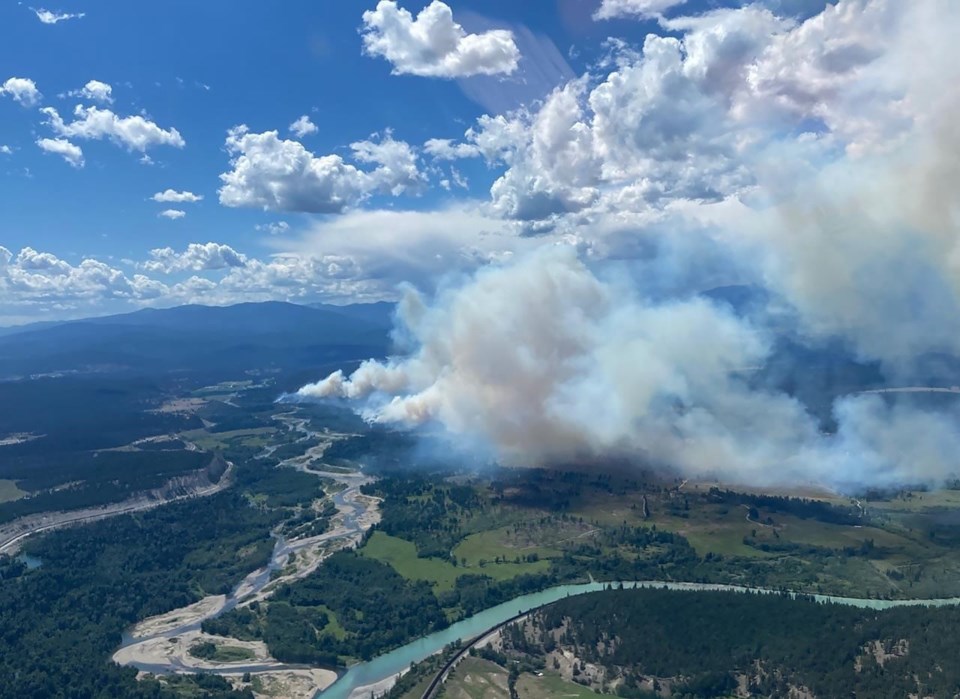VANCOUVER — British Columbia hasn't yet hit the "peak" of its wildfire season, but it has already broken the record for the total area burned in a year, the province's minister of emergency management said.
Officials are now eyeing the prospect of drought-driven conditions rolling into 2024, setting the stage for a similarly disastrous fire season unless there is "significant precipitation" in winter, Bowinn Ma said on Tuesday.
"It is significant and there's likely more to come," Ma said on Tuesday. "We know that the road ahead of us is long, complex and challenging."
The BC Wildfire Service website said that 14,100 square kilometres have been burned since April 1, as of 6 p.m. Tuesday, surpassing the previous full-year record of 13,543 square kilometres set in 2018. The service was reporting about 400 fires currently burning and 21 fires of note, where they are a threat to safety or are especially visible to the public.
There have been 1,203 fires so far in 2023, suggesting the average size of fires this year has been about 84 per cent larger than in 2018.
Recent data had previously prompted the federal government and B.C. Premier David Eby to say that Canada and B.C. were on track to record their worst wildfire seasons in 100 years.
BC Wildfire Service spokesman Cliff Chapman said forecasting models "don't look great for the rest of the summer."
"With the amount of lightning we saw in this province over the course of the last 10 days coupled with the drought that we are experiencing, we have high potential for holdover fires," he said.
Sophie Wilkinson, an assistant professor in environmental management at Simon Fraser University, said the fires are aggravated by severe drought conditions in many areas of the province.
"We can expect the fires that are currently burning to keep burning for a while," she said in an interview. "We're going to see a lot more hectares burned."
B.C.'s drought bulletin shows 18 of the province's 34 water basins are at drought Level 4, meaning harm to ecosystems and communities is likely. A further four are at the highest Level 5, when all efforts should be made to conserve water and protect critical environmental flows.
Ma said officials are concerned about long-term drought conditions, with potential impacts being forecast for the 2024 wildfire season.
"If we do not get significant precipitation over the winter and into the spring, those reservoirs might not recharge the way that they normally expect them to and that could mean earlier drought conditions (and) another wildfire season that is like what we've seen this year," Ma told the news conference. "We are attempting to assess and understand what those long-term impacts are."
Wilkinson said the wildfire season is "unprecedented" because other provinces and territories have also been suffering badly, stretching interprovincial resources thin.
"Although military aid has not been common in the past, it will become increasingly common because the severity of both British Columbia and Canada's wildfire seasons is increasing because of climate change," Wilkinson said in an interview.
The federal government has offered assistance, including military resources to help with B.C.'s wildfire fight.
Two companies of Canadian Armed Forces troops are arriving in B.C. this week to join the battle, bringing helicopters and a Hercules aircraft, while the province has asked for 1,000 more international firefighters to join crews from four countries already on the ground.
Ma said during a news conference that 75 soldiers would arrive in Vanderhoof Tuesday and another 75 members were expected to be deployed to Burns Lake Wednesday. Both areas are considered fire hot spots.
"The Canadian Armed Forces will be directly involved with fighting fires and the Canadian Coast Guard will support the management operations and administrative activities of the BC Wildfire Service's incident command posts," she told the conference.
Ma said she's thankful the federal government quickly approved B.C.'s request, adding that talks about the assistance and length of deployments are ongoing.
"This support is substantial, robust and will give British Columbia the tools and personnel it needs to keep people safe," she said.
"These federal resources will join teams from Australia, as well as more than 350 international personnel currently in place in B.C. from the U.S., Mexico and New Zealand. These teams work alongside the approximate 2,000 BC Wildfire Service personnel across B.C."
Dozens of properties have been put on evacuation order or alert in the Kootenay region in B.C.'s southeast after new wildfires near Cranbrook temporarily shut the city's airport on Monday.
While resources are currently adequate, Chapman said the BC Wildfire Service has requested additional pumps and hoses from the Canadian Interagency Forest Fire Centre, which co-ordinates firefighting resources across the country. He said they have approved the request and the equipment is expected in the coming days.
"We aren't the only jurisdiction that is seeing a significant wildfire season in Canada," he added. "Quebec, Alberta, Yukon, Northwest Territories — the list is kind of growing and it gets added to seemingly as we enter into July and August."
In Ontario, there are currently 66 active wildfires in the province. Of those, 12 are out of control, three are being held, two are under control and 49 are being observed.
Quebec officials reported 101 active fires Tuesday afternoon, 22 of them in the more-populated southern half of the province. Much of the Saint Lawrence River Valley, including the Montreal area, and regions to its west and north, are subject to smog warnings as smoke from the fires in Western Canada drifted across the continent.
Environment Canada is meanwhile reporting that parts of the Northwest Territories are seeing record-breaking temperatures as heat waves sweep the country. Air-quality advisories have been issued for several communities across the territory due to wildfire smoke.
The weather agency has also issued air-quality warnings for parts of B.C.,northern Alberta and northern Saskatchewan.
This report by The Canadian Press was first published July 18, 2023.
Brieanna Charlebois, The Canadian Press




